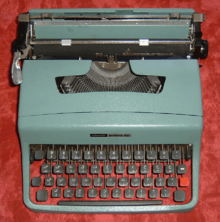Olivetti Lettera 32
The Olivetti Lettera 32 is a portable mechanical typewriter designed by Marcello Nizzoli for Olivetti in 1963 as the successor of the popular Olivetti Lettera 22. This typewriter was popular amongst journalists and students.
The typewriter is sized about 34x35x10 cm (with the carriage return lever adding about 1-2 more centimeters in height), making it portable at least for the time's standards, even though its 5.9 kg weight may limit portability somewhat.
Mechanics
The Lettera 32 is a downstrike typebars typewriter. The typebars strike a red/black inked ribbon, which is positioned between the typebar and the paper by a lever whenever a key is pressed; a small switch located near the upper right side of the keyboard can be used to control the strike position of the ribbon, in order to print with black, red, or no ink (for mimeograph stencils).
Ribbon movement, which also occurs at every keypress, automatically reverses direction when there is no ribbon left on the feed reel; two mechanical sensors, situated next to each wheel, move when the ribbon is put under tension (indicating ribbon end), attaching the appropriate wheel to the ribbon transport mechanism and detaching the other.
Keyboard

The keyboard uses QWERTY, AZERTY and various other layouts. Apart from the typing keys, the keyboard includes a Space bar, two Shift keys, a caps lock, a backspace key, margin release key, paragraph indentation key and a tab-stop set/unset key.
The character set conspicuously lacks the number 1, which is supposed to be substituted by the lowercase l. Although this may seem like a strange absence today, this was common on older typewriters. There is also no exclamation mark character on the keyboard; instead this is typed by a period, then a backspace, and then an apostrophe.
Popular culture
Cormac McCarthy used an Olivetti Lettera 32 to write nearly all of his fiction, screenplays, and correspondence - totalling by his estimate more than 5 million words. The Lettera 32 that he purchased in 1963 was auctioned by Christies on 12/4/09 to an unidentified American collector for $254,500, more than 10 times its high estimate of $20,000.[1] McCarthy paid $20 for a replacement typewriter of the same model, but in newer condition.[1]
See also
References
- 1 2 Kennedy, Randy (2009-12-04). "NY Times: Cormac McCarthy's Typewriter Brings $254,500 at Auction". The New York Times. Retrieved 2009-12-04.